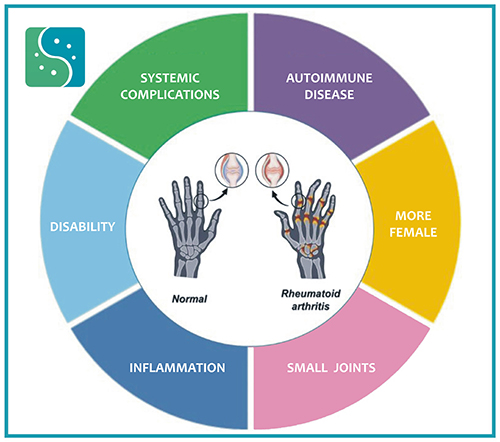RHEUMATOID ARTHRITIS is a type of arthritis where your immune system attacks the tissue lining the joints on both sides of your body. It may affect other parts of your body too. The exact cause is unknown.
Homoeopathy can be a great boon for all those suffering from rheumatoid arthritis. As Homoeopathic prescription is based upon carefully analysis of the symptoms of the patients, it becomes a system of medicine that understands and treat the patients individualized disease characteristics deeply enough to ensure the complete elimination of the disease from the roots. Homoeopathic medicines regulate the immune system and deactivates the misdirected immune cells. They also help in reducing the inflammation in the joints too. The treatment have a role to play in controlling the progress of the condition to some extent and in delaying the onset of complications.
Rheumatoid arthritis is a complex chronic disorder and needs to be evaluated properly before any prescription is made. Homoeopathy is based on the principle of individualisation and symptom similarity by using holistic approach.
Rheumatoid arthritis is a chronic inflammatory disorder that can affect more than just your joints. In some people, the condition can damage a wide variety of body systems, including the skin, eyes, lungs, heart and blood vessels.
An autoimmune disorder, rheumatoid arthritis occurs when your immune system mistakenly attacks your own body's tissues.

Unlike the wear-and-tear damage of osteoarthritis, rheumatoid arthritis affects the lining of your joints, causing a painful swelling that can eventually result in bone erosion and joint deformity.
The inflammation associated with rheumatoid arthritis is what can damage other parts of the body as well.
Rheumatoid arthritis affects everyone differently. In some people, joint symptoms develop over several years. In other people, rheumatoid arthritis symptoms progress rapidly. Many people have time with symptoms (flares) and then time with no symptoms (remission).
Symptoms of rheumatoid arthritis include:
Rheumatoid arthritis is an autoimmune disease. Normally, your immune system helps protect your body from infection and disease. In rheumatoid arthritis, your immune system attacks healthy tissue in your joints. It can also cause medical problems with your heart, lungs, nerves, eyes and skin. An infection, smoking or physical or emotional stress may be a triggering factor for disease. The exact cause of rheumatoid arthritis is unknown. Researchers think it’s caused by a combination of genetics, hormones and environmental factors.
There are several risk factors for developing rheumatoid arthritis. These include.
Rheumatoid arthritis increases your risk of developing:
Rheumatoid arthritis can be difficult to diagnose in its early stages because the early signs and symptoms mimic those of many other diseases. There is no one blood test or physical finding to confirm the diagnosis.
During the physical exam, your doctor will check your joints for swelling, redness and warmth. He or she may also check your reflexes and muscle strength.
Blood tests
People with rheumatoid arthritis often have an elevated erythrocyte sedimentation rate (ESR, also known as sed rate) or C-reactive protein (CRP) level, which may indicate the presence of an inflammatory process in the body. Other common blood tests look for rheumatoid factor and anti-cyclic citrullinated peptide (anti-CCP) antibodies.
Imaging tests
Your doctor may recommend X-rays to help track the progression of rheumatoid arthritis in your joints over time. MRI and ultrasound tests can help your doctor judge the severity of the disease in your body.
These self-care measures, when used along with your rheumatoid arthritis medications, can help you manage your signs and symptoms:
The pain and disability associated with rheumatoid arthritis can affect a person's work and family life. Depression and anxiety are common, as are feelings of helplessness and low self-esteem.
The degree to which rheumatoid arthritis affects your daily activities depends in part on how well you cope with the disease. Several steps can be taken like:
Rheumatoid Arthritis usually starts to develop between the ages of 30 and 60. But anyone can develop rheumatoid arthritis. In children and young adults, usually between the ages of 16 and 40, it’s called young-onset rheumatoid arthritis (YORA). In people who develop symptoms after they turn 60, it’s called later-onset rheumatoid arthritis (LORA).
The symptoms of a rheumatoid arthritis flare aren’t much different from the symptoms of rheumatoid arthritis. But people with RA have ups and downs. A flare is a time when you have significant symptoms after feeling better for a while. With treatment, you’ll likely have periods of time when you feel better. Then, stress, changes in weather, certain foods or infections trigger a period of increased disease activity.
Rheumatoid arthritis and osteoarthritis are both common causes of pain and stiffness in joints. But they have different causes. In osteoarthritis, inflammation and injury break down your cartilage over time. In rheumatoid arthritis, your immune system attacks the lining of your joints.
If you have rheumatoid arthritis, you may feel like you’re on a lifelong roller coaster of pain and fatigue. It’s important to share these feelings and your symptoms with your doctor. Homoeopathy is strongly suggested for the cases of rheumatoid arthritis as when selected constitutionally they can alleviate the pain and also have a role to play in controlling the progression of the disease. Homoeopathic treatment for rheumatoid arthritis is a patient-oriented science and medicines are prescribed on the characteristics of the individual rather than just the symptoms of the disease. . For individualized remedy selection and treatment, the patient should consult a qualified homoeopathic doctor in person.